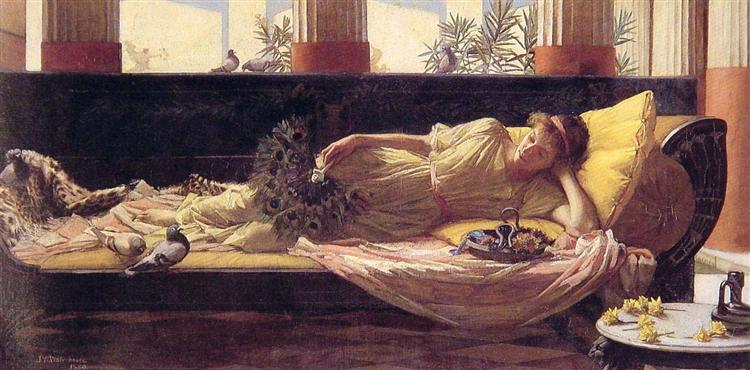Beschreibung
Das Gemälde "ist süß, nichts zu tun" (1880) von John William Waterhouse verkaps die Essenz der angenehmen Ablumme in einer natürlichen Umgebung und lädt den Betrachter zu einer ruhigen und fast traumhaften Kontemplation ein. Waterhouse, ein herausragender Vertreter der vor -rrafaelitischen Bewegung, fällt auf, dass er die visuelle Erzählung mit raffinierter Ästhetik in Einklang bringt, und diese Arbeit ist keine Ausnahme. Auf der Leinwand scheint sich die zentrale Figur einer jungen Frau, die sich lehnte, dem Charme ihrer Umgebung zu ergeben. Die Darstellung seiner Haltung, die halbgebunden und in einen diaphanischen Stoff eingewickelt ist, der sowohl Transparenz als auch Weichheit hindeutet, überträgt einen Hauch von Sorgfalt und Zufriedenheit.
Die Farben in der Arbeit sind hell und reichlich gesättigt, überwiegend Grün- und Blautöne, die die Gelassenheit der Landschaft, die die Figur umgeben, hervorruft. Die Nuancen der Erde, die auf dem Boden und auf den umliegenden Pflanzen zu finden sind, kontrastieren mit dem blassen Kleid von Frauen und unterstreichen ihre fast ätherische Präsenz. Waterhouse verwendet meisterhaft leicht; Die Beleuchtungsquelle unterstreicht die empfindlichen Merkmale des weiblichen Körpers und bietet eine weiche und umhüllende Atmosphäre, die den Betrachter einladen scheint, sich diesem Ruhemittel anzuschließen.
Die Zusammensetzung ist gleich signifikant; Die Figur befindet sich in einer Weise, wie er den natürlichen Hintergrund betrachtet, was darauf hindeutet, dass seine Betrachtung nicht nur für seine unmittelbare Umgebung vorbehalten ist, die durch zarte Blüten und überschwängliche Vegetation verziert ist - sondern auch für das Gefühl der Selbstbeobachtung. Diese Herangehensweise an den kontemplativen Aspekt und die Verbindung des Menschen mit der Natur ist ein wiederkehrendes Thema in Waterhouses Arbeit und verbindet seine Arbeit mit der breiteren Ästhetik der Vorbereitung, die die Schönheit der Natur und des individuellen Ausdrucks hervorhebt.
Das Malerei kann jedoch auch ein Gefühl der Nostalgie hervorrufen. Das Gefühl, nichts zu tun, kann als Kommentar zu den Rhythmen des modernen Lebens gegen die Gelassenheit der Ruhe interpretiert werden, ein Raum, in dem die Zeit zu stoppen scheint. In einer Zeit, in der die Industrialisierung Gesellschaften veränderte, bietet Waterhouse eine alternative Vision, eine Pause für die Seele, die sich deutlich mit der neuen Ära der hektischen Aktivität widersetzt.
"Es ist süß, nichts zu tun" ist mit anderen Waterhouse -Werken ausgerichtet, die Themen von Frauen in idyllischen Landschaften wie "The Siren" oder "The Guardian of the Brunnen" präsentieren. Diese Arbeiten feiern nicht nur weibliche Schönheit, sondern deuten auch auf Momente der Reflexion und auf eine subtile Beziehung zwischen dem Subjekt und dem natürlichen Umfeld hin. In diesem Sinne erfasst Waterhouse nicht nur ein Bild, sondern befürwortet auch eine Rückkehr in die einfachen und gelassenen.
Zusammenfassend ist Waterhouses Werk eine Feier der Schönheit und Kontemplation, die die Süße der Freizeit meisterhaft auf einer lebendigen und poetisch erzählten Leinwand verkörpert. "Es ist süß, nichts zu tun." Das Gemälde schwingt weiterhin mit und bietet nicht nur eine ästhetische Freude, sondern auch eine Einladung, über die Beziehung zu Zeit und Natur nachzudenken.
KUADROS ©, eine berühmte Farbe an Ihrer Wand.
Handgefertigte Ölgemälde, mit der Qualität professioneller Künstler und dem unverwechselbaren Siegel von KUADROS ©.
Pictures Reproduction Service mit Zufriedenheitsgarantie. Wenn Sie mit der Nachbildung Ihres Gemäldes nicht vollständig zufrieden sind, erstatten wir Ihr Geld zu 100%.

